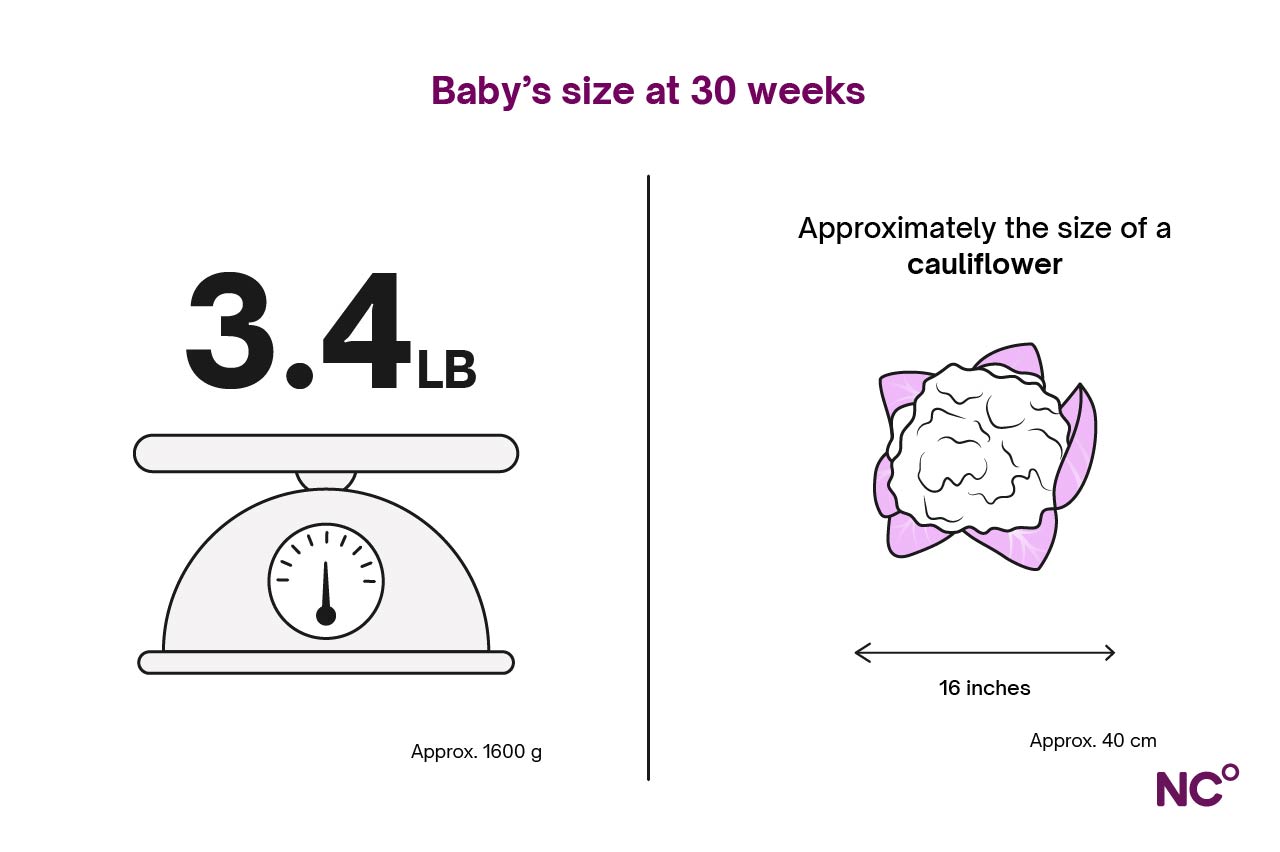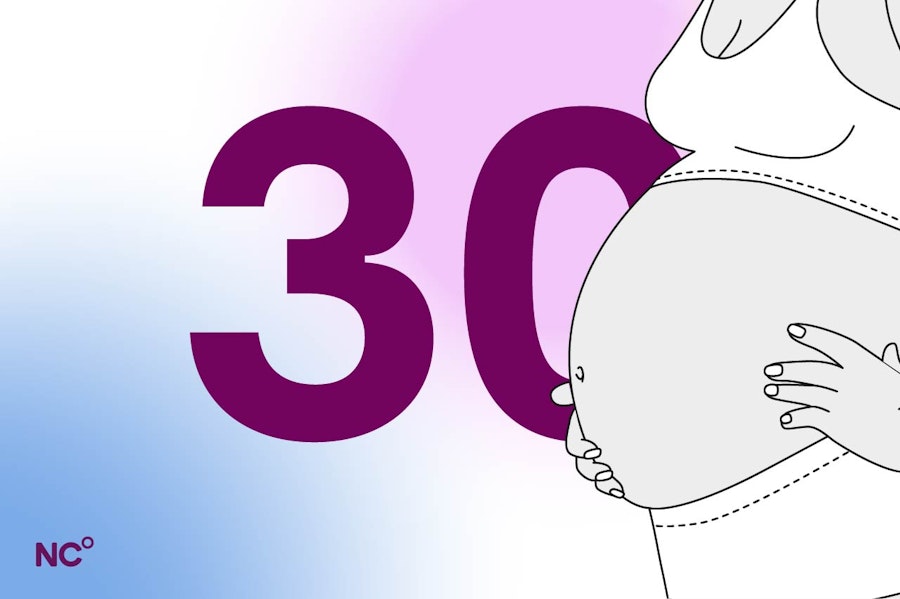30 Weeks pregnant: Baby development, symptoms & signs
Follows NC° Editorial Policy
At Natural Cycles, our mission is to empower you with the knowledge you need to take charge of your health. At Cycle Matters, we create fact-checked, expert-written content that tackles these topics in a compassionate and accessible way. Read more...
Key takeaways
- Changes to your feet and belly button might seem strange, but are completely normal at this stage of pregnancy
- Keep an eye on physical pregnancy symptoms like discharge and swelling
- Your baby’s eyes are wide open now, and their vision is continuing to improve
Welcome to week 30! You are now at least three-quarters of the way through your pregnancy journey. Your growing belly and your baby’s constant kicks are both reminders of how just much your baby has grown. Physical and mental pregnancy symptoms you might have experienced in the first trimester, like mood swings, could return this week. You might also notice changes to your feet and belly button. In this article, we will guide you through the changes going on in your body and baby’s development this week, along with helpful tips to support you as you head towards the finish line.
Your body at week 30
Belly button
You might have noticed that as your stomach has grown, your belly button has changed shape. Depending on the size and positioning of your uterus, and how the skin on your stomach has stretched, your navel can even become tender or painful [1]. Try to wear loose-fitting clothes or cover it lightly with an adhesive bandage if contact with clothing becomes irritating. A maternity support band might also help [1]. If you have a pierced belly button, consider removing jewelry. This can alleviate discomfort and help prevent infection [1].
If you notice your belly button or the area around it has become hard or swollen, contact your healthcare provider as this might be a sign of an umbilical hernia [2]. Umbilical hernias occur when the pressure caused by your growing uterus pushes the intestines through the abdominal muscles and into your belly button [3]. Hernias have not been shown to harm the pregnancy, or baby. In many cases, they are treatable without surgery [1].
Growing feet?
Are you finding that your shoes are not fitting properly? It is not unusual to require a half or full-size larger shoe, particularly in your third trimester. For some women, swelling in the feet can make your normal shoes feel suddenly tight or uncomfortable. While your feet might return to their original size after giving birth, it is actually not uncommon for your feet to stay larger after giving birth.
Doctors are not sure why this happens, but it has been suggested that changes in your body during pregnancy can have permanent effects on the shape of your feet [4]. Weight gain and a shifting center of gravity both affect the way you walk, putting pressure on different parts of your foot, like the ball, arch, and heel. Fallen arches, in particular, have been investigated for causing women’s feet to get longer during pregnancy and stay longer afterward [4]. Stretching, compression socks, frequent light exercise, not consuming too much salt, and wearing supportive shoes (in the correct size) are all good ways to help care for your feet during pregnancy [5].
Mood swings
Week 30 can bring the return of early pregnancy symptoms like mood swings. Mood swings can be caused by physical stress, fatigue, changes in your metabolism and hormones like estrogen and progesterone [6]. Shifts in moods are particularly common in the first and third trimesters of pregnancy, when hormonal changes are most severe [6]. Sleep, exercise, fresh air, and a healthy diet can all help manage this unpredictable symptom [6].
If you find that your mood swings are becoming stronger, or more frequent, or if you find you are feeling sad or low more often, talk to your healthcare provider. It is possible you might be experiencing depression or anxiety. Untreated mental or emotional health issues can increase your risk of preterm labor, and increase your risk of postpartum depression [7]. Asking for help can feel daunting, but you don’t need to do this alone. Remember pregnancy is different for everyone and there is no right or wrong way to feel.
Your baby’s development at 30 weeks
It might be hard to believe, but at 30 weeks you have now been pregnant for over 7 months! After many months of rapid growth and development, the pace of growth is beginning to slow during these weeks as your baby prepares to enter the world. At 30 weeks, your baby’s eyes are continuing to develop and can open wide, noticing the difference between light and dark [8]. At 30 weeks, your baby can follow a source of light with their eyes and even focus on objects immediately in front of them [8].
At week 30, your baby is likely between 15-16 inches (38-40 cm) long and weighs around 3 to 3.4 pounds (1.4-1.6 kilograms) [8]. This is around the size of a large head of cauliflower.

Pregnancy Symptoms during week 30
Pelvic Pain
Pelvic pain, sometimes called pelvic girdle pain (PGP) or symphysis pubis dysfunction (SPD) is the general term given to stiffness and discomfort in and around your pelvic area. While it is not harmful to your baby, PGP can be extremely painful and make it difficult to get around. PGP tends to affect around 1 in 5 pregnant women [9]. It can occur at any point in your pregnancy, but can become more common later in pregnancy as the baby grows, forcing you to change how you sit or stand and placing more pressure on the pelvis [9]. Though it can be very painful for you, PGP does not harm your baby.
To help manage pelvic discomfort, try to maintain good posture while sitting and standing, being sure to not sit or stand for more than 30 minutes at a time [9]. As much as possible, avoid lifting or carrying anything heavy, even grocery bags, going up and down stairs too frequently, or stooping, bending, or twisting to lift or carry things [9]. If pain becomes unmanageable, contact your HCP about other courses of treatment, including physiotherapy. PGP usually improves after childbirth, although around 1 in 10 women will continue to experience PGP once the baby is born [9].
Discharge
You have probably noticed changes in your vaginal discharge over the course of the last few months, particularly an increase in clear or white discharge. Brown discharge containing old blood is also common, particularly after having sex because the cervix is more sensitive.
Towards the end of pregnancy, it is common to experience additional increases in discharge [10]. Before labor begins, some women might notice sudden thick discharge that can be clear with streaks of pink. This is known as the mucus plug, which is the mucus that has been in your cervix during pregnancy. It is a sign that the body is bringing to prepare for birth.
In some cases, certain types of vaginal discharge can be a sign of a problem, particularly in later pregnancy. Contact your healthcare provider if [10]:
- You experience vaginal bleeding, or bright red discharge
- You suspect your mucus plug has come out before 36 weeks
- You have discharge that is green, or smells bad
Swelling
General swelling during pregnancy is very normal and the result of your body retaining more water when you are pregnant. Swelling caused by water retention is also known as edema [11]. Because of gravity, your legs and feet tend to experience the worst swelling. A growing baby also puts extra pressure on your body, which can affect blood flow and worsen swelling further [12].
Swelling can be exacerbated by standing for long periods of time and being outside when it is very hot [12]. For this reason, try to avoid standing and if you are on your feet, try to walk around to increase blood flow. There are foot exercises you can do to help blood circulation and ankle swelling, including rotating your feet at the ankles and flexing and extending your ankles [12]. If it is safe to do so in your pregnancy, daily walking is a good way to reduce swelling in the feet.
If you experience sudden swelling in your face, hands, or feet, contact your healthcare provider promptly. Quick onset of swelling along with headache, vision problems, and nausea can be a sign of preeclampsia, which can be a very serious condition involving blood flow in the placenta. Preeclampsia affects around 5-8% of pregnancies and is usually detected during the last half of a pregnancy [13]. Speak to your doctor to learn more.
Tips in week 30
- Start thinking about childbirth. It might seem early, or even scary, but talking to your HCP and researching different birthing and pain relief options can help you make informed decisions and hopefully stay calmer when the moment comes.
- Check if you are up-to-date on your vaccines. RSV, COVID-19, influenza, and Tdap vaccines might be recommended and available to you depending on where you live. Up-to-date vaccines are also recommended for anyone who will be around your newborn, like close friends, family, siblings, caregivers, and partners.
- Think about your hospital bag. If you know already where you will be giving birth, the hospital or birth center might have guidelines or suggestions available online of what to pack to help make you more comfortable, and also what you will need to bring to take your baby home.
- Begin making arrangements for other children or pets for when labor begins. Labor can begin unexpectedly, and it is important to have plans in place to prevent any extra stress when it starts.
- Keep checking fetal movements. The closer you get to your due date, the more important it is to keep regularly checking on how your baby is moving in the womb.
- Try stretching out your pelvis. A good way to relieve pelvic discomfort or lower back pain is to try pelvic tilts and circles. For tilts, sit on a chair or gym ball and slowly rotate your pelvis forwards, curving your spine, and backward, reaching your head up tall. If you have a gym or birthing ball, you can try pelvic circles - moving your pelvis around in small, circular motions, remembering to change directions.
Following your pregnancy with Natural Cycles
You can use the Natural Cycles app to track your pregnancy using NC° Follow Pregnancy. Access more weekly guidance to help you navigate the prenatal journey, becoming better informed on the changes going on in your body and how your baby is developing. You can also use the app to track your physical and mental health symptoms throughout your pregnancy. After birth, use NC° Postpartum to help recuperate from childbirth and manage postpartum life.
Did you enjoy reading this article?
